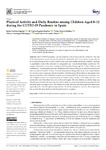Mostrar o rexistro simple do ítem
Physical Activity and Daily Routine among Children Aged 0–12 during the COVID-19 Pandemic in Spain
| dc.contributor.author | Cachón Zagalaz, Javier | |
| dc.contributor.author | Zagalaz Sánchez, Mª Luisa | |
| dc.contributor.author | Arufe-Giráldez, Víctor | |
| dc.contributor.author | Sanmiguel-Rodríguez, Alberto | |
| dc.contributor.author | González Valero, Gabriel | |
| dc.date.accessioned | 2021-03-29T11:31:35Z | |
| dc.date.available | 2021-03-29T11:31:35Z | |
| dc.date.issued | 2021 | |
| dc.identifier.citation | Cachón-Zagalaz, J.; Zagalaz-Sánchez, M.ªL.; Arufe-Giráldez, V.; Sanmiguel-Rodríguez, A.; González-Valero, G. Physical Activity and Daily Routine among Children Aged 0–12 during the COVID-19 Pandemic in Spain. Int. J. Environ. Res. Public Health 2021, 18, 703. https://doi.org/10.3390/ijerph18020703 | es_ES |
| dc.identifier.uri | http://hdl.handle.net/2183/27627 | |
| dc.description.abstract | [Abstract] The COVID-19 pandemic has impacted the lives of many people. Objective: The aim of the present study was to analyse the physical activity (PA) and daily routine among children (0–12 years) during lockdown and to establish the main relationships among the variables. Methods: A quantitative study with a descriptive–comparative and cross-sectional design carried out. The sample, selected for convenience, consisted of 837 Spanish children aged 0–12. The “Children and confinement” questionnaire was used, distributed electronically through Google Forms and social networks and activated for 45 days. The individuals participating in this study were mainly children (50.2%) who were in primary education (44.8%). Predominantly, the families of participants were biparental (87.9%), with established routines and schedules (85.7%). Results and conclusions: The use of digital screens is an important part of children’s daily routine. Their daily activities were practiced for more than three–six years, with more by girls. The time children devoted to sleep was directly proportional to the time they devoted to physical activity and indirectly proportional to the time they spent watching screens. The children who slept the most were those aged zero–three years, especially girls, who belonged to large families. The levels of physical activity in the sample were low, as were the times spent on activities such as music or games. | es_ES |
| dc.language.iso | eng | es_ES |
| dc.relation.uri | https://doi.org/10.3390/ijerph18020703 | es_ES |
| dc.rights | Atribución 4.0 Internacional | es_ES |
| dc.rights.uri | https://creativecommons.org/licenses/by/4.0/ | * |
| dc.subject | COVID-19 | es_ES |
| dc.subject | Children | es_ES |
| dc.subject | Lockdown | es_ES |
| dc.subject | Physical activity | es_ES |
| dc.subject | Daily activities | es_ES |
| dc.title | Physical Activity and Daily Routine among Children Aged 0–12 during the COVID-19 Pandemic in Spain | es_ES |
| dc.type | info:eu-repo/semantics/article | es_ES |
| dc.rights.access | info:eu-repo/semantics/openAccess | es_ES |
| UDC.journalTitle | Environmental Research and Public Health | es_ES |
| UDC.volume | 18 | es_ES |
| UDC.issue | 2 | es_ES |
| UDC.startPage | 703 | es_ES |
| dc.identifier.doi | doi.org/10.3390/ijerph18020703 |
Ficheiros no ítem
Este ítem aparece na(s) seguinte(s) colección(s)
-
UI- UNIDEF - Artigos [35]






